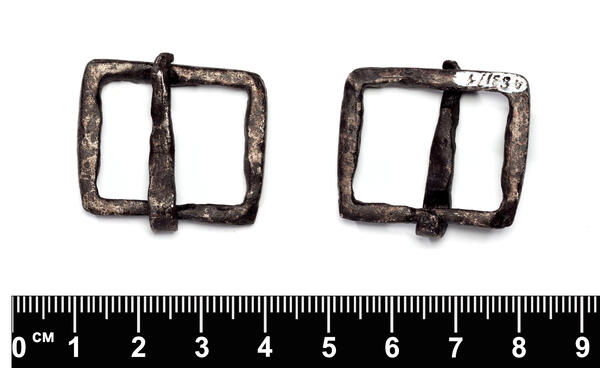The permanent exhibition “Relics from the Battle of Kulikovo” features a forged iron piece of horse equipment dating back to the 12th–14th centuries — a buckle with a sub-rectangular frame measuring 3.2×2.6 cm with rounded ends. The part was forged from a cane which was 0.3 cm thick and rectangular in cross section. The sides of the frame are slightly flattened — they are 0.5 cm wide. The length of the prong is 2.8 cm. It is made of a rectangular cane and measures 0.5 cm near the hinge. The end of the prong is pointed.
In 2003, this buckle was discovered in excavations conducted by the military-historical unit of the Upper-Don archaeological expedition of the State Historical Museum and the State Military-Historical and Natural Museum-Reserve “Kulikovo Field” on the watershed of the Verkhodub and Orzhevik ravines, to the south of the Monastyrshchino village, Kimovsky District, Tula Oblast, on site No. 22, grid 1. The buckle is currently housed by the State Museum-Reserve “Kulikovo Field”.
Judging by the size of the frame of the buckle, it connected the ends of the belt that were no more than 2 cm wide. The item could well belong to the bridle set of a military horse or the belt set of a professional warrior. The buckle belongs to the type of multifunctional belt buckles.
In the early Middle Ages, a rider was, first of all, a professional combatant. He possessed considerable combat skills and expensive equipment. From the 10th to the 13th century, a specially trained warhorse was a knight’s “living” weapon, and his equipment — the bridle, the saddle, and other elements — had the same technical characteristics as his weapon. Parts of horse tack, which date back to the period from the second half of the 10th century to the early 12th century, were produced by ordinary blacksmiths and gunsmiths. It was not until the 12th and 13th centuries that special skills were required to manufacture horse accessories for riding, harnessing, saddling and controlling horses. The information from written sources about saddlers dates back to exactly that period.
In 2003, this buckle was discovered in excavations conducted by the military-historical unit of the Upper-Don archaeological expedition of the State Historical Museum and the State Military-Historical and Natural Museum-Reserve “Kulikovo Field” on the watershed of the Verkhodub and Orzhevik ravines, to the south of the Monastyrshchino village, Kimovsky District, Tula Oblast, on site No. 22, grid 1. The buckle is currently housed by the State Museum-Reserve “Kulikovo Field”.
Judging by the size of the frame of the buckle, it connected the ends of the belt that were no more than 2 cm wide. The item could well belong to the bridle set of a military horse or the belt set of a professional warrior. The buckle belongs to the type of multifunctional belt buckles.
In the early Middle Ages, a rider was, first of all, a professional combatant. He possessed considerable combat skills and expensive equipment. From the 10th to the 13th century, a specially trained warhorse was a knight’s “living” weapon, and his equipment — the bridle, the saddle, and other elements — had the same technical characteristics as his weapon. Parts of horse tack, which date back to the period from the second half of the 10th century to the early 12th century, were produced by ordinary blacksmiths and gunsmiths. It was not until the 12th and 13th centuries that special skills were required to manufacture horse accessories for riding, harnessing, saddling and controlling horses. The information from written sources about saddlers dates back to exactly that period.




